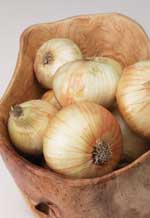Sweet Vidalia
The story of the Vidalia onion goes back more than 70 years, when a farmer in Toombs County by the name of Mose Coleman noticed that his onion crop had a sweet, rather than hot, taste. Early on he struggled to convince people that it was a viable product, but he still managed to sell his entire first crop. By the 1940s, the onions could be found in the State Farmer’s Market in Vidalia, which is how they got their name. Production grew slowly over the next several decades, but by 1977 the Vidalia onion had earned its own festival. By 1980, the onion had its own mascot; in 1990, it was named the official vegetable of the State of Georgia; and in 1991, the Vidalia Onion Hall of Fame was created to recognize the efforts of individuals who had contributed to the growth and awareness of the crop.
Today, this Georgia delicacy boasts nationwide acclaim, and one of its biggest fans is the highly lauded chef of Restaurant Eugene, Linton Hopkins. An Atlanta native, he says that what makes Vidalia onions special is the natural sweetness they possess. It’s a flavor so good that the chef says he would eat them raw, with just a little sprinkle of salt and pepper. In fact, when the onions are in season (late spring to early summer), they are all he uses. “I like to use them in succotash, soups, or even roasted whole; when you roast them, they get a wonderful meaty, savory quality,” Hopkins says.

To see–and taste–what all the fuss over these sweet onions is about, go to Restaurant Eugene where the menu changes nightly.
Restaurant Eugene
2277 Peachtree Road
Atlanta, GA 30309
(404) 355-0321; restauranteugene.com
At The Store
Vidalia onions are a sweet variety from granex-type seeds that give them a less harsh smell. Like all produce, they are best when purchased at the peak of their ripeness. You will find that a lot less work goes into preparing them when they already have that great fresh flavor. The crops are typically harvested from the late spring through the early summer, so this month is the perfect time to enjoy them. Through technology borrowed from the apple industry, known as “controlled atmosphere,” Vidalia onions can be stored for several months, but you will still get the best flavor by buying–and cooking–them now. Try to find them with a little dirt and the greens still on them, indicating that they probably haven’t been stored long before reaching the store; the greens can be used for cooking as well.
RECIPE:
Succotash Stuffed and Braised Vidalia Onions
Serves 4
4 large Vidalia onions
1 1/4 cups rich chicken stock
3 tbsp. whole sweet butter
Salt
Black pepper
Peel onions and remove all but the three outer rings. Brush onions with softened butter and season well. Next stuff onions with succotash mix (recipe follows) and place in a buttered roasting pan or dutch oven. Pour chicken stock into pot, cover and roast at 350∞ for 45 minutes. Gently place an onion in the center of a plate. Reduce pan juices to a glaze and spoon over the onion. Salt and pepper to taste.
Succotash
1/2 cup bacon, julienned
3/4 cup cooked lima beans
3/4 cup cooked sweet corn kernels
2 tbsp. chopped garlic
3 tbsp. julienned parsley
1/4 cup heavy cream
Heat the bacon in a pan until crisp, remove and reserve. Drain off all but 1 tablespoon of bacon fat. Sauté the garlic in bacon fat until soft, being careful not to burn; add lima beans and corn; cook for 30 seconds. Next add cream and parsley; reduce cream until bound around the vegetables. Season and reserve.






